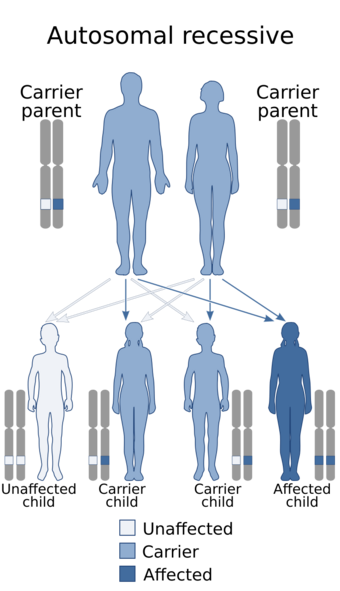Medicine:D-Glyceric acidemia
| D-Glyceric acidemia | |
|---|---|
| Other names | D-glycerate kinase deficiency |
 | |
| This condition is inherited in an autosomal recessive manner. | |
D-Glyceric acidemia (a.k.a. D-Glyceric aciduria) is an inherited disease, in the category of inborn errors of metabolism. It is caused by a mutation in the gene GLYCTK, which encodes for the enzyme glycerate kinase.
Pathophysiology
Glycerate kinase is an enzyme that catalyzes the conversion of D-glyceric acid (a.k.a. D-glycerate) to 2-phosphoglycerate. This conversion is an intermediary reaction found in several metabolic pathways, including the degradation (break-down; catabolism) of serine,[1] as well as the breakdown of fructose.[2]
A deficiency in glycerate kinase activity leads to the accumulation of D-glyceric acid (a.k.a. D-glycerate) in bodily fluids and tissues.[3] D-glyceric acid can be measured in a laboratory that performs analyte testing for organic acids in blood (plasma) and urine.[4]
Symptoms of the disease (in its most severe form) include progressive neurological impairment, mental/motor retardation, hypotonia, seizures, failure to thrive and metabolic acidosis.[5]
Related conditions
D-Glyceric acidemia should not be confused with L-Glyceric acidemia (a.k.a. L-glyceric aciduria, a.k.a. primary hyperoxaluria type II[6]), which is associated with mutations in the GRHPR (encoding for the enzyme 'glyoxylate reductase/hydroxypyruvate reductase').[7][8]
Diagnosis
References
- ↑ Surtees, Robert; Poll-The, Bwee-Tien; Berger, Ruud; Duran, Marinus; Snell, Keith; Koning, Tom J. de (May 2003). "Biochem. J. (2003) 371, 653-661 - T.J. de Koning and others - l-Serine in disease and development". Biochemical Journal 371 (3): 653–661. doi:10.1042/bj20021785. PMID 12534373.
- ↑ Hommes, F. A. (1993). "Inborn errors of fructose metabolism". Am J Clin Nutr 58 (5): 788S–795S. doi:10.1093/ajcn/58.5.788S. PMID 8213611. http://www.ajcn.org/content/58/5/788S.
- ↑ "GLYCTK - glycerate kinase - Genetics Home Reference". http://ghr.nlm.nih.gov/gene/GLYCTK.
- ↑ "GeneTests: Search Results". https://www.ncbi.nlm.nih.gov/sites/GeneTests/lab/clinical_disease_id/22208?db=genetests.
- ↑ Physician's Guide to the Laboratory Diagnosis of Metabolic Diseases. Springer. 2003. ISBN 9783642627095. https://www.springer.com/life+sciences/biochemistry+%26+biophysics/book/978-3-540-42542-7.
- ↑ "# 260000 HYPEROXALURIA, PRIMARY, TYPE II; HP2". https://www.ncbi.nlm.nih.gov/omim/260000.
- ↑ "Primary Hyperoxaluria Type 2". GeneReviews®. University of Washington, Seattle. 1993. https://www.ncbi.nlm.nih.gov/bookshelf/br.fcgi?book=gene&part=ph2.
- ↑ "OMIM Entry - * 604296 - GLYOXYLATE REDUCTASE/HYDROXYPYRUVATE REDUCTASE; GRHPR". https://www.ncbi.nlm.nih.gov/omim/604296.
External links
| Classification | |
|---|---|
| External resources |
- Genetics Home Reference (National Library of Medicine) [1] (information on D-glyceric acidemia and the GLYCTK gene)
- OMIM [2] (information on GLYCTK gene, encoding Glycerate Kinase)
- GeneTests [3] (information on genetic testing for D-Glyceric Acidemia)
 |

